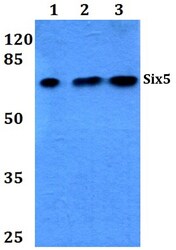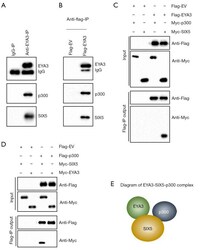Antibody data
- Antibody Data
- Antigen structure
- References [1]
- Comments [0]
- Validations
- Western blot [1]
- Other assay [1]
Submit
Validation data
Reference
Comment
Report error
- Product number
- PA5-75417 - Provider product page

- Provider
- Invitrogen Antibodies
- Product name
- SIX5 Polyclonal Antibody
- Antibody type
- Polyclonal
- Antigen
- Synthetic peptide
- Description
- The antibody was affinity-purified from rabbit antiserum by affinity-chromatography using epitope-specific immunogen and the purity is > 95% (by SDS-PAGE).
- Reactivity
- Human, Mouse, Rat
- Host
- Rabbit
- Isotype
- IgG
- Vial size
- 100 μL
- Concentration
- 1 mg/mL
- Storage
- Store at 4°C short term. For long term storage, store at -20°C, avoiding freeze/thaw cycles.
Submitted references Both a hypoxia-inducible EYA3 and a histone acetyltransferase p300 function as coactivators of SIX5 to mediate tumorigenesis and cancer progression.
Yang C, Liu H
Annals of translational medicine 2022 Jul;10(13):752
Annals of translational medicine 2022 Jul;10(13):752
No comments: Submit comment
Supportive validation
- Submitted by
- Invitrogen Antibodies (provider)
- Main image

- Experimental details
- Western blot analysis of SIX5 in Lane 1: HEK293T whole cell lysate, Lane 2: Raw264.7 whole cell lysate, Lane 3: PC12 whole cell lysate. Samples were incubated with SIX5 polyclonal antibody (Product # PA5-75417) at a dilution of 1:500.
Supportive validation
- Submitted by
- Invitrogen Antibodies (provider)
- Main image

- Experimental details
- The assembly of EYA3-SIX5-p300 complex in vivo and in vitro . (A) EYA3 pulled down both SIX5 and p300 in cancerous biopsies. Three independent cancerous were mixed with equal weights and were then immunoprecipitated using anti-EYA3 (or IgG, negative control) conjugated agarose. The output complexes were probed with antibodies as indicated in the figure. (B) EYA3 pulled down both SIX5 and p300 in HCEC-1CT cells expressing pCDNA3-Flag-EYA3. (C,D) Detection of direct interaction of EYA3-p300, EYA3-SIX5, p300-SIX5, and p300-EYA3 in vitro . Different combinations of plasmids as shown in the figure were transfected into HCEC-1CT cells, followed by immunoprecipitation with anti-Flag- and anti-Myc-agarose. The outputs were probed using anti-Flag and anti-Myc. (C) Interactions of EYA3-p300 and EYA3-SIX5. (D) Interactions of p300-SIX5 and p300-EYA3. (E) Schematic assembly of the EYA3-SIX5-p300 complex. IgG, immunoglobulin G.
 Explore
Explore Validate
Validate Learn
Learn Western blot
Western blot